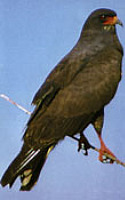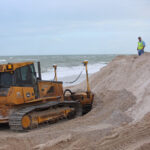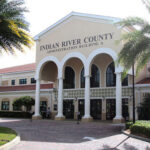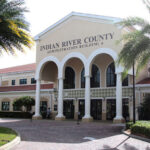
FELLSMERE – Boaters are being asked to stay away from areas of cattails and to remove every last shred of water weeds from their propellers before launching into a new body of water.
The request comes from environmental researchers and the Florida Fish and Wildlife Conservation Commission as a way to protect the endangered snail kite and prevent the spread of herbicide resistant hydrilla.
The hydrilla is “really successful in surviving,” Stacia Hetrick, of the University of Florida/IFAS Osceola County Extension, told members of the Indian River County Airboat Association at their monthly meeting Monday night. “It gets really out of hand if it’s not managed.”
Airboat member Mike Hearndon questioned the management of the hydrilla, telling Hetrick and Aquatic Plant Biologist Ed Harris that when the hydrilla is killed, the frogs go away.
“No frogs, no hydrilla,” Hearndon said. “They go hand in hand.”
He told the environmentalists that they might want to keep some areas of hydrilla for the food chain, rather than removing it all.
Harris, of the Florida Fish and Wildlife Conservation Commission, told the airboaters that the agency doesn’t have the resources to kill all the hydrilla – it’s enough for them to keep the waterways navigable and keep water control devices free from the weed.
The Indian River County Airboat Association invited the scientists to speak at the meeting to also address the arrival of an endangered bird species to Blue Cypress Lake.
Some snail kites, a hawk-sized bird with a severely hooked beak, have taken to nesting in the cattails around the lake, making their nests vulnerable to high winds and changing water levels.
“I keep hearing if it weren’t for the snail kites, the east marsh would have been drained long ago,” Airboat Association Secretary Kim Emmons said. She told the group that it was her hope to educate the boaters on the birds so they can continue to use the marsh east of County Road 512 near Fellsmere.
While the birds are moving into Blue Cypress, many more have relocated to Lake Toho in the Kissimmee chain of lakes after being displaced from the Everglades and Lake Okeechobee due to the decline of natural conditions.
Without the vegetation they had grown accustomed to in the Everglades, Aquatic Plant Biologist Ed Harris told members of Indian River County Airboat Association, the birds are now nesting in cattails.
“The cattails just don’t do that well,” he said. The snail kites are having difficulty getting their offspring to survive into adulthood.
Harris said the birds are starting to get used to the airboats on the water, but only in non-high traffic areas. The FWC has posted signs warning boaters to a nearby nest and reminding them to stay 500 feet away.
He said it is not the agency’s intent to make vast areas off limits to boaters. Instead, the agency wants to educate water users.
Another issue environmentalists are running into is the arrival of exotic apple snails, which serve as a food source for adult snail kites. However, the exotic snails are too large for the young snail kites and the exotics are crowding out the native, much smaller apple snails.
“This is causing a unique problem,” Hetrick said, because the birds have specialized in this one food source. The exotics are good for the adults, but not so for the young – the next generation.
Harris said the FWC is working on ways to rehabilitate the Everglades and Lake Okeechobee to entice the snail kites to return to their more successful nesting grounds.
However, with the massive amounts of non-native snakes and lizards being released into the area, he said the agency doesn’t want the birds to move back to “python central” where they would be eaten.
Boaters who spot an unmarked nest hidden in the cattails are asked to contact the FWC’s snail kite coordinator, Zach Welch, to report it so a sign can be installed and researchers can monitor the nest.
Welch can be reached at (352) 266-6139 or by e-mail at zach.Welch@myfwc.com.
Boaters with questions about water weeds, including hydrilla, should contact Ed Harris at (407) 275-4004 or ed.harris@myfwc.com.






